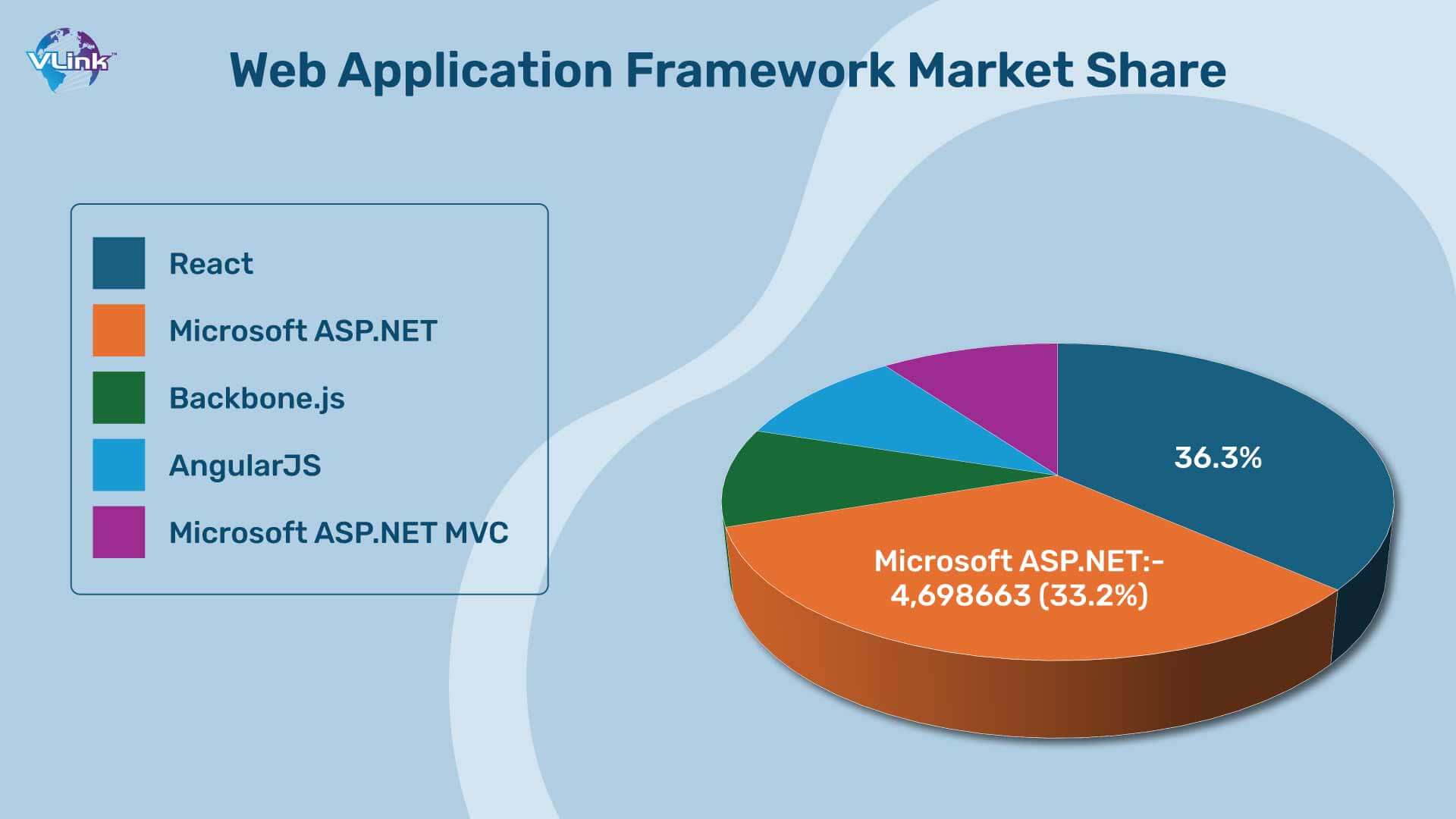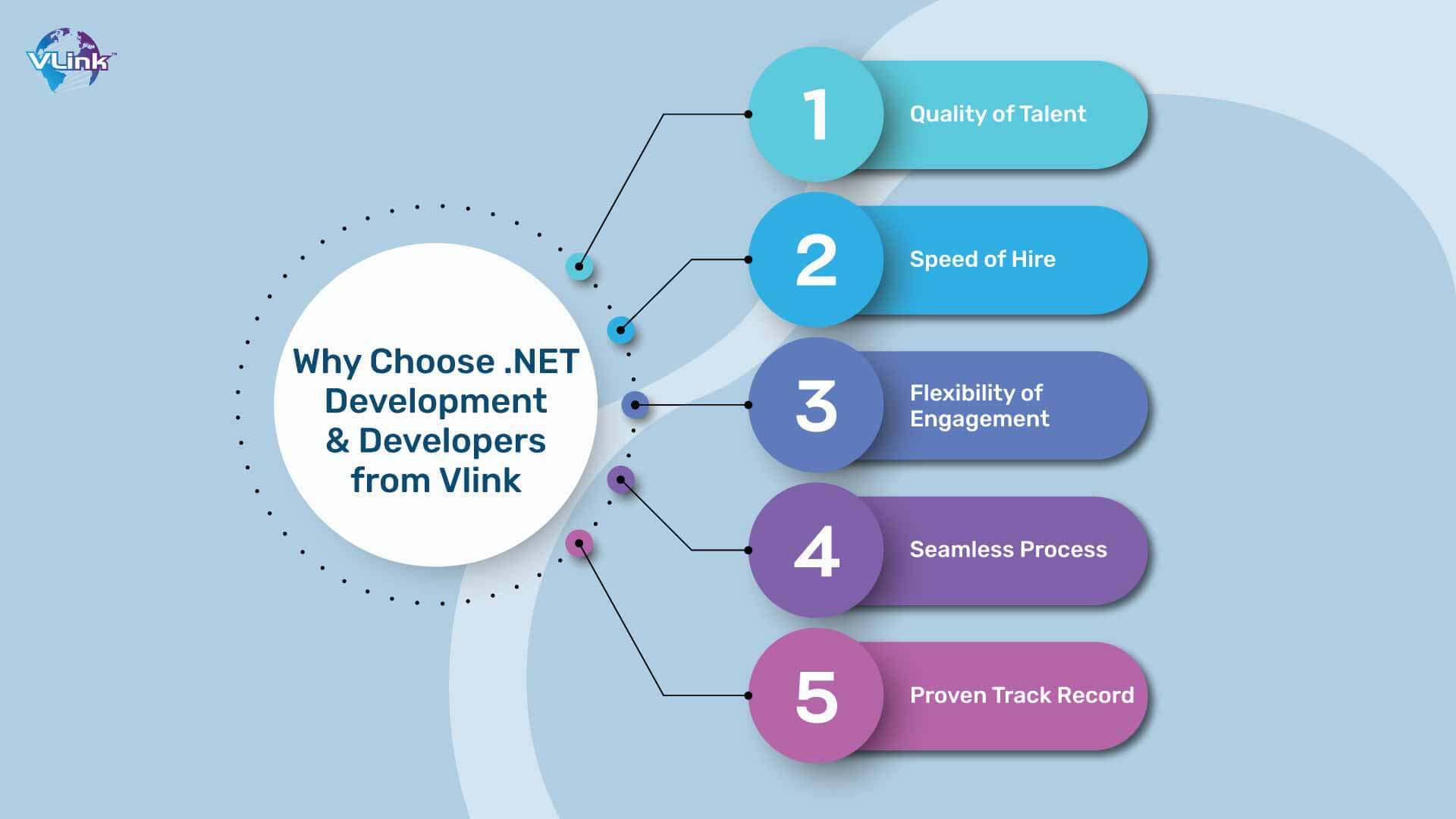ASP.NET boasts a strong presence in the web development world, ranking as the second most popular framework with a market share of 23.19% as per the W3Techs, 2024 survey. Over 38 million active websites rely on it, demonstrating its widespread adoption. This data shows a high demand for skilled ASP.NET developers, attracting an average salary of $108,000 annually in the US (As per Indeed Data, 2024). Interestingly, its popularity varies geographically, with the US taking the lead followed by India, Russia, China, and Germany (As per SimilarWeb Data, 2024).
When it comes to specific versions, ASP.NET MVC reigns supreme at 53%, followed by ASP.NET Core at 34% and the classic ASP.NET Web Forms at 13% ( As per BuiltWith Data, 2024). The Below Image represents the global web application framework marker share in 2024.

If you're a new developer or an experienced developer working with ASP.NET web applications, you must hear about troubleshooting issues. These issues are an inevitable part of the job. Whether it's about various debugging errors, addressing performance bottlenecks, or dealing with various deployment challenges, mastering the art of troubleshooting is crucial for maintaining an efficient web application.
This blog covers common ASP.NET web application problems and provides actionable tips to diagnose and resolve them effectively. Let’s start!
Step-by-step guidance for isolating ASP.NET issues

Building dynamic web applications with ASP.NET is gratifying, but even the most meticulously crafted code can encounter bumps. Understanding effective troubleshooting approaches is crucial to maintaining application stability and user satisfaction when errors arise.
Gather Information:
- Reproduce the Issue: Can you consistently replicate the problem under controlled conditions? Gather info and proceed further.
- Collect Error Messages: Pay close attention to codes, stack traces, and additional information.
- Document User Context: Understand the user's actions, browser, and system details leading up to the error.
Leverage Diagnostics and Logging:
- Enable Detailed Error Logging: Capture comprehensive messages and debug info.
- Utilize Browser Developer Tools: Network and Console tabs offer debugging aids.
- Employ Performance Profiling Tools: Pinpoint bottlenecks with Visual Studio profiler or third-party solutions.
Isolate the Root Cause:
- Review Logs and Stack Traces: Scrutinize error messages for clues about the source.
- Analyze Error Patterns: Look for repeated errors or trends indicating common causes.
- Test Individual Components: Temporarily disable application parts to isolate potential culprits.
Implement a Solution:
- Research and Validate: Utilize documentation, forums, and online resources for proven solutions.
- Test Thoroughly: Rigorously test fixes in a controlled environment before deployment.
- Implement and Monitor: Deploy the fix and keep an eye on application behavior for regressions.
READ MORE: Hire Certified DotNet Developers to Augment your IT Team
Common ASP.NET Troubleshooting Scenarios
500 Internal Server Error:
- Check log files for detailed messages.
- Investigate common causes like configuration issues, permission problems, or coding errors.
- Use debugging tools to isolate the error-causing line.
- Advanced Tip: Analyze server event logs for broader clues.
HTTP 404 Not Found:
- Verify the requested resource exists in the correct location.
- Ensure URL routing is configured correctly.
- Check for typos or mismatched casing in file paths.
- Advanced Tip: Utilize URL rewriting rules to handle missing resources gracefully.
Performance Bottlenecks:
- Use profiling tools to identify slow-running code sections.
- Optimize database queries: Create indexes, improve query logic, and reduce unnecessary data fetching.
- Cache frequently accessed data to minimize redundant processing.
- Enable compression to reduce response sizes and improve transmission speed.
- Advanced Tip: Consider load-balancing solutions to distribute traffic across multiple servers.
Proactive Strategies for Smooth ASP.NET Troubleshoot
- Version Control: Track changes with Git and easily revert if needed.
- Test Early and Often: Implement unit and integration tests to catch errors early.
- Continuous Integration/Continuous Delivery (CI/CD): Automate build, test, and deployment processes.
- Stay Updated: Regularly update your ASP.NET framework and libraries for security and performance improvements.
- Security First: Implement robust security measures to prevent unauthorized access and malicious attacks.
READ MORE: Why Should You Hire Dot Net Developer?
Advanced Troubleshooting Techniques

- Unit Testing: Frameworks like NUnit, xUnit, and MSTest automate the testing of individual code units.
- Debugging: Step through code line-by-line using breakpoints and watches to pinpoint issues.
- Memory Debugging: Identify memory leaks or inefficient memory usage with tools like Visual Studio's Memory Profiler or dotTrace.
- Debugging Asynchronous Code: Utilize specialized techniques like async breakpoints and inspecting task maintenance.
- Exception Handling: Gracefully handle exceptions with try-catch blocks to prevent crashes and provide meaningful error messages.
- Profiling: Identify performance bottlenecks beyond code-level issues. Tools like dotTrace analyze application performance across various aspects.
Demystifying Error Messages:
- HTTP Status Codes: Familiarize yourself with common codes like 404 (Not Found).
- ASP.NET-Specific Errors: Consult the documentation for explanations and solutions to these framework-specific error messages.
- Stack Traces: Learn to read and interpret these roadmaps of function calls leading to the error, pinpointing the exact line of code responsible.
Powerhouse Tools for Troubleshooting:
- Visual Studio Developer Tools: Network tab for inspecting requests/responses, Console tab for logging, debugger for stepping through code.
- Profiling Tools: Visual Studio Profiler, dotTrace, or PerfView analyze CPU usage, memory allocation, and other performance metrics.
- Logging Frameworks: NLog, log4net, and Serilog capture error messages, debug information, and custom events for detailed analysis.
- Code Editors with Debugging: Visual Studio Code and JetBrains Rider provide debugging features like breakpoints, watches, and call stacks.
Real-World Case Studies
Case Study 1:
Resolving a Performance Bottleneck in a Shopping Cart Application.
Symptoms: Slow checkout times during peak hours.
Troubleshooting Steps:
- Profiling: Identified inefficient database queries fetching unnecessary product data.
- Optimization: Optimized queries, implemented caching, and indexed relevant tables.
- Result: Significant improvement in checkout performance.
Case Study 2:
Debugging an Authentication Issue in a Web App.
Symptoms: Irregular "Unauthorized Access" errors for users.
Troubleshooting Steps:
- Analyzing Logs and Breakpoints: Revealed a bug in cookie handling within the authentication code.
- Fix and Testing: Fixed the bug and added unit tests to prevent recurrence.
- Result: Resolved the authentication issue for users.
Point To Remember:
- Patience, methodical steps, and the right tools are key to effective troubleshooting.
- Stay updated with ASP.NET features and security patches.
- Share experiences and learnings with the community to contribute to collective knowledge.
Beyond the Basics:
- Security Audits and Penetration Testing: Proactively identify and address security vulnerabilities.
- Third-Party Libraries and Components: Ensure they are up-to-date and troubleshoot issues specific to them.
- Cloud-Based Deployments: Leverage cloud provider troubleshooting tools and diagnostics.
Continuous Learning:
- Stay updated with the latest ASP.NET advancements and best practices.
- Explore new troubleshooting techniques and tools.
- Participate in online communities and forums for knowledge sharing.
By following these guidelines, mastering the techniques presented, and continuously sharpening your skills, you can effectively conquer ASP.NET web application problems and ensure a seamless user experience. Remember, becoming a troubleshooting master is continuous and filled with learning!
READ MORE: How to Hire Dot NET Developers For 7 Days Risk-Free Trial?
Why Choose .NET Development & Developers from Vlink

In today's competitive landscape, selecting the right technology partner is crucial for the success of ASP.NET web development projects. Vlink, a leading IT services and talent company, offers unparalleled advantages for businesses seeking top-notch .NET development expertise.
Let's delve deeper into why you should consider .NET development and developers from Vlink:
- Quality of Talent: Vlink boasts a diverse team of highly skilled .NET developers with extensive experience in building complex web applications, leveraging the latest technologies and best practices to deliver exceptional results.
- Speed of Hire: With Vlink's robust recruitment process and vast talent pool, businesses can quickly onboard skilled .NET developers to kickstart their projects, minimizing time-to-market and gaining a competitive edge.
- Flexibility of Engagement: Vlink offers flexible engagement models tailored to the unique needs and preferences of each client, whether it's dedicated team augmentation, project-based engagements, or full-cycle development services.
- Seamless Process: From project inception to delivery, Vlink ensures a seamless and transparent development process, fostering open communication, collaboration, and accountability throughout the project lifecycle.
- Proven Track Record: With a proven track record of successfully delivering high-quality .NET projects for clients across diverse industries, Vlink introduces confidence and reliability, helping businesses achieve their strategic objectives and growth milestones.
By partnering with Vlink for .NET development needs, businesses can confidently leverage cutting-edge technology solutions, accelerate innovation, and drive digital transformation.
READ MORE: Hire a Dedicated Team of Remote .Net Developers?
Wrap-Up!
Troubleshooting ASP.NET web application problems can be a challenging task, but with the right approach and tools, it can be effectively managed. By following the steps outlined in this blog and adopting best practices for application development and maintenance to ensure the smooth operation of their ASP.NET applications. Ready to conquer ASP.NET problems? Connect with us. Thanks!
Frequently Asked Questions
- Inefficient Database Queries
- Poorly Optimized Code
- Excessive Resource Consumption
- Lack of Caching Mechanisms
- Write clean and well-tested code.
- Implement thorough error handling and logging.
- Regularly monitor application performance and resource usage.
- Stay up-to-date with ASP.NET security patches and framework updates.
- Visual Studio developer tools (Network, Console tabs).
- Performance profiling tools (Visual Studio profiler, third-party options).
- Logging frameworks (NLog, log4net, Serilog).
- Code editors with debugging capabilities (Visual Studio Code, JetBrains Rider).








